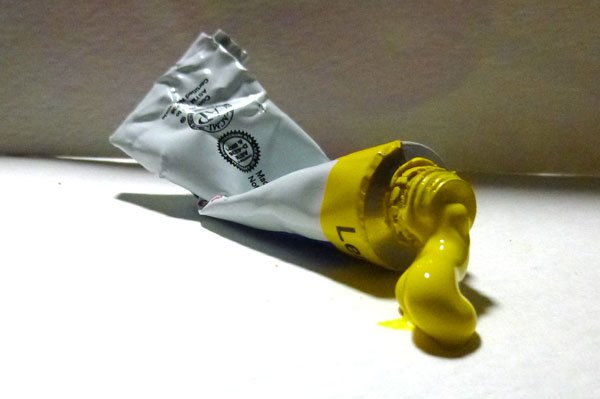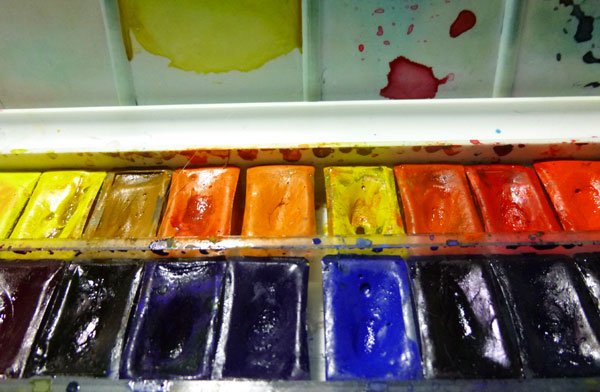Watercolor Tubes vs. Pans – Which are Better?
One of the hardest parts of getting started with watercolors is knowing which paints to buy. There are so many choices!
First you have to decide if you are going to test the waters (so to speak) with student-grade paints, or if you are going to fork out the extra money for artist-grade paints instead.
Next, you have to slog through about a million different brands of paint, comparing and contrasting each one so you can find the best brand.
After all that, you are still left with one more major decision…should you buy tubes or pans?
To be honest, the “tubes versus pans” debate doesn’t really have a clear winner. I think the choice really comes down to which type of paint will work best with your unique style of painting. To help you decide whether watercolor tubes or pans are best for your needs, I’ve listed the pros and cons of each below:
Watercolor Tubes – Pros and Cons

Pros of Watercolor Tubes:
- Tube paint is ideal for mixing large batches of paint. This makes it a good choice if you do large-scale paintings or need to create washes that cover vast areas of paper.
- For maximum color intensity, the paint can be used straight from the tube without adding any additional water. While watercolor pans can provide the same level of color intensity, they require more work to create a fully saturated mix.
Cons of Watercolor Tubes:
- Getting ready to paint takes longer than painting with watercolor pans since you have to take additional time to uncap and squeeze out each color of paint that you plan to use.
- It can be difficult to judge how much of each color you need, which in turn can lead to wasted paint. Of course, you can allow any excess paint to dry on the palette and rewet it to use again later. However, some tube paints are difficult to rewet once they are dry. They may lose some of their color intensity or take on a grainy appearance. If you want, you can avoid this problem by adding a small amount of glycerin to them when you squeeze them out on the palette. The glycerin helps keep them from fully drying and makes it easier to achieve the original vibrant color when you rewet them at a later date.
- It is extremely difficult to keep tube paints from getting contaminated with other colors on your palette. Once the original color is lost, it is practically impossible to retrieve.
- Tubes are bulky and take up more space than pans.
- Unless you keep your paints organized in a logical order, it can be difficult to see all of your colors at a glance and find the ones you need.
- The tubes themselves can cause problems. For instance, caps can get stuck with dried paint, or the tubes can crack or burst as they age.
Watercolor Pans – Pros and Cons

Pros of Watercolor Pans
- Watercolor pans and compact and easy to store.
- Pans are far more portable than tubes, which makes them ideal for taking with you if you plan to paint outdoors or away from your studio.
- Getting ready to paint takes practically no time. Just spray your paints with a little bit of water to wet them and you are ready to go — no need to take extra time to unscrew caps and squeeze out paint.
- Less wasted paint. You only use what you need instead of having to guess how much to squeeze out.
- If the surface of the pan becomes contaminated with another color, all you have to do is wipe away the offending color and the paint underneath is unaffected.
Cons of Watercolor Pans:
- It is more difficult to mix large quantities of paint with pans than with tubes — especially if you require thick mixes. Mixing enough paint for large paintings or washes is possible, but it takes more work than with tube paint.
- Pans can be a little harder on you brushes if you aren’t careful when you use them. You may be tempted to scrub at the pan with your brush to try to pick up paint, which can be really hard on the bristles. To avoid brush damage, make sure that your paints are thoroughly dampened before you dip your brush in them. Also, use a light touch when moving the bristles of the brush across the surface of the paint.
I hope this helps you decide whether to go with watercolor tubes or pans.
For what it’s worth, I decided to go with a pan set myself. So far I am really loving them. They are easy to use, the colors are amazing and I love the fact that I don’t waste a lot of paint. In the future I plan to pick up a tube each of red, yellow and blue paint to add to my collection. That way I can use my pan set for everyday painting, and use the tube paint when I need to mix large quantities of paint for background washes. That way I can have the best of both worlds!
Please feel free to comment below if you have any questions or have anything to add. Thanks so much for reading!
Share...
16 thoughts on “Watercolor Tubes vs. Pans – Which are Better?”
Leave a Reply
You must be logged in to post a comment.

thank you for sharing this, very helpful information!!! love the pans but the tubes do, indeed, help with covering big areas much quicker
Thanks for taking time to post such a clear resume! Do you have advice on the best brush type or hair?
Unfortunately, I don’t really know a lot about brushes. I tend to just use cheap synthetic ones and haven’t had any problems. I do generally prefer round brushes over some of the other styles, simply because they are so versatile. You can use them to make fine lines or wide, sweeping strokes, depending on how you hold them and how much pressure you use. I just bought a little set of five round synthetic brushes on Amazon for under $10.00 and have been loving them. I know a lot of brush purists will probably cringe at that, but for me it’s what works. If I remember right sable brushes are supposed to hold a lot more water than synthetic brushes, which would probably make them useful for doing washes or for soaking up excess water/paint from your paper. That’s about the extent of my knowledge, though. Sorry I can’t be more helpful!
Thanks for sharing. This helped me decide very quickly. 🙂
You bet! 🙂
I was tempted to buy pan pastels, now I’m sure… thank you.
I ment watercolors… lol
No problem! 🙂
Being an oil painter I just can get the hang of the pans. I think (notice I say I think) mixing the color and then deciding to add water would be easier just given my background with oils. I have no clue.
Making the jump from oils to watercolors does seem like it would be challenging. I can see why using tubes would seem easier since it is more like the process used with oils. The one thing that they both have in common is that it often takes a lot of layers to get the colors just right. I think the more that you play around with watercolors, the more intuitive the color mixing/layering process will become. Good luck with it and have fun! 🙂
Really appreciate your taking the time to compare and contrast the differences of pans versus tube paints. I intend to follow your example and use pans and supplement with tubes for washes. Thank you.
I’m glad you found it helpful! 🙂 Thanks for stopping by!
Just searched this topic through google and your article was on the top result. Thanks for sharing!
you bet! 🙂
Thanks! I’m going to try some pans after years of tubes. 🙂
I hope you find them as fun and useful as I have! 🙂